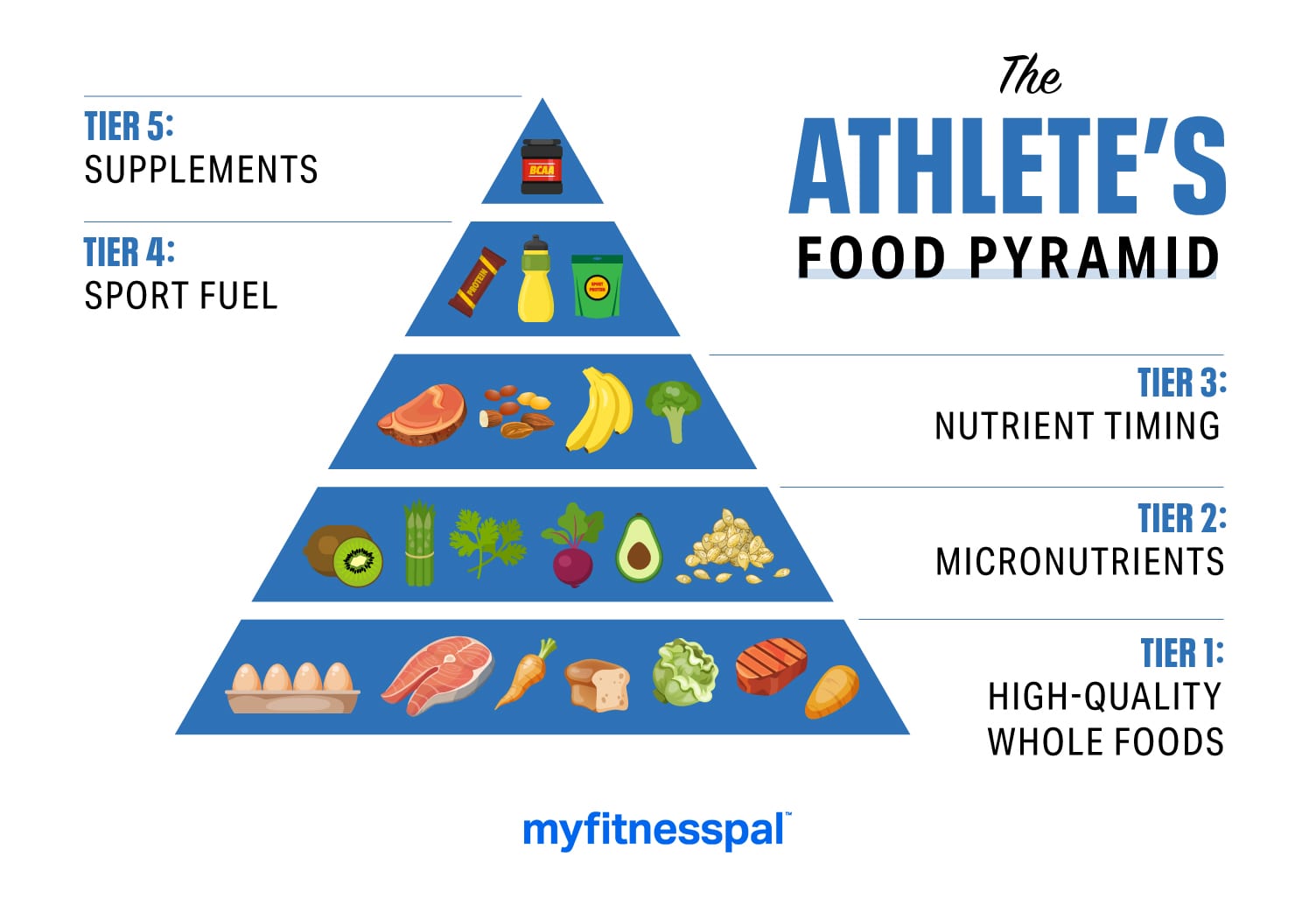Mind Your Minerals: A Deep Dive into Micronutrient Optimization
This article delves into the critical roles of micronutrients in athletic performance, offering a systematic review of how vitamins and minerals contribute to an athlete's health, recovery, and ability to excel. It underscores the necessity of a balanced intake of micronutrients like Vitamin A, B, C, D, E, K, iron, zinc, selenium, and more, and discusses when supplementation might be appropriate. Practical advice is blended with scientific insight to guide athletes and fitness enthusiasts in optimizing their micronutrient consumption for peak performance.
WN
By Workout Notepad
March 03, 2024

The Starting Block: Importance of Micronutrients for Athletes
Micronutrients are the silent support crew in an athlete’s quest for peak performance, often overlooked yet vital for the various physiological demands of strenuous activity. Imagine a distance runner neglecting the intake of iron, a mineral imperative for the transportation of oxygen in the blood – even a marginal deficiency could sap the athlete of their usual vigor, leading to lackluster performances or training setbacks. This applies to a myriad of scenarios; a gymnast who doesn’t maintain a balanced intake of calcium and vitamin D might compromise their bone health, raising the risk of fractures. Elite competitors may consume calorie-dense diets to meet their high energy demands but can still fall short on micronutrients, which are not always proportionate to caloric intake. Without these critical dietary components, athletes might face decreased immune function, impaired muscle function, and longer recovery times, ultimately undercutting their goals.
The journey towards achieving and maintaining a fine—almost symphonic—balance of these microscopic dietary elements is akin to preparing for a marathon, with each vitamin and mineral representing an integral runner in the grand event of sustaining high athletic performance. The starting block is set up for the discussion to move forward into identifying these runners—the teeming roster of micronutrients and the unique roles each plays. As essential as it is to consume these micronutrients through a well-rounded diet, pin-pointing and understanding each one’s function will open the arena for further optimizing an athlete’s nutrition. Ensuring the team of micronutrients are well-represented in an athlete’s diet is the foundation, the training ground from which an athlete’s success can be built, leading into the next section of this in-depth look at the individual micronutrients that form the core of an athlete’s dietary regimen.
The Micronutrient Marathon: What Every Athlete Needs

micronutrient foods athletic performance
As athletes rigorously train and compete in their respective sports, maintaining a meticulously balanced nutritional regimen becomes tantamount to a well-run marathon. In this race of essential vitamins and minerals, each micronutrient represents a dedicated runner whose performance is critical for the athlete’s overall success. B vitamins, much like pace-setters in a long-distance event, aid in the steady release of energy neither too hastily nor too slowly, ensuring the athlete can sustain effort over time. Iron is the runner with the fortitude to transport oxygen efficiently, a deficiency in which can dramatically slow the pace of progress. Calcium and Vitamin D take stride in lockstep as the dynamic duo fostering strong bones—essential not just for the race today, but also for the athlete’s longevity in the sport. Concurrently, other runners such as coenzyme Q10 and ashwagandha play their part in improving physical performance and enhancing endurance, respectively, permitting athletes to push the boundaries of their capabilities without falling prey to exhaustion.
The metaphorical race is not just about speed but also about resilience and intelligent pacing governed by nutrients that safeguard against cramps and fatigue. As our athlete runners approach the next crucial ‘hydration station’, the narrative focus shifts to the role of key minerals like potassium, magnesium, and sodium. Here, these minerals are not just participants, but are the very sustenance—as water to a marathon runner—that prevent the body from hitting the proverbial wall of muscle cramps and compromised fluid balance. The upcoming section will serve to quench the thirst for knowledge on how to effectively integrate these elemental allies into the athlete’s journey, ensuring that the sweat of exertion does not lead to cramps or dehydration but translates into the tears of triumph crossing the finish line.
Hydration Station: Minerals for Fluid and Electrolyte Balance

hydration minerals athlete
Rounding the curve in the nutritional marathon, athletes enter the critical ‘hydration station’—a phase just as paramount as the starting block. Minerals such as potassium, magnesium, and sodium come under the spotlight here for their essential roles in fluid balance and muscle function. While a track athlete knows to grab water during a break, understanding the intricate balance of electrolytes that maintain optimal hydration levels is equally critical; it’s the difference between winning and cramping up. The synchronized interplay of these minerals keeps bodily fluids in check, facilitating nerve impulses and muscle contractions, and a deficiency or excess can disrupt this balance, leading to muscle cramps or even more serious conditions such as hyponatremia. Collegiate track and field throwers, a group that largely grasps the significance of staying hydrated, nonetheless encounter hurdles—such as the logistics of water access during practice and misconceptions around sports drinks—that impede implementing this knowledge effectively. This gap between understanding and execution underscores the urgent need for targeted education around the nuanced roles of electrolytes in an athlete’s hydration strategy to promote both safety and peak physical performance.
As athletes continue to push their bodies and approach the limits of their endurance, the journey takes them to ‘Hitting the Wall,’ a tolling phase where the warning signs of micronutrient deficiencies begin to emerge. Subtle hints of excessive fatigue, muscle weakness, or unreliable performance could be signals that the body is running low on its essential minerals buffer—a quandary that the simplistic Workout Notepad, with its ability to track exercise and pinpoint anomalies in routines, can help recognize. By connecting the dots between observed athletic performance and nutritional intake, athletes and coaches can work to prevent deficiencies before they manifest more severely, ensuring that the marathon continues seamlessly towards victory.
Hitting the Wall: Recognizing Micronutrient Deficiencies
In the grueling journey of athletic training, ‘hitting the wall’ often signifies a critical moment of challenge—a breakpoint where the demand on the body’s resources surpasses its nutrient reservoirs. This collapse is not just a moment of physical exhaustion but can also be a tell-tale sign of micronutrient deficiencies. Athletes with low levels of calcium may experience weakened bones and frequent fractures, while inadequate iron can trigger chronic fatigue and hampered endurance. Those deficient in vitamin D might find their muscle repair slowed, zinc shortage can dull the immune response, and a dearth of magnesium can lead to relentless muscle cramps. B vitamins, pivotal for energy production, when under-supplied, might translate into depleted vigor and impaired cognitive function during competitions and training. A clever way to monitor and manage an athlete’s nutrition and performance is by using tools like the Workout Notepad from Gym Notebook Replacement Resources. By meticulously jotting down daily exercise routines and reviewing exercise graphs, athletes and coaches can identify trends in performance that may highlight a possible link back to inadequate intake or absorption of vital nutrients.
Spotting these deficiencies early is critical, as interventions can be as straightforward as nutritional adjustments or, when necessary, can extend to strategic supplementation. It is essential for athletes to recognize that a decline in performance, unexplained fatigue, or frequent injuries might suggest a more significant issue at hand. When dietary adjustments fail to yield improvements, this might cue the need for reinforcements in the form of supplements—situations that are expounded upon in the upcoming section. Here, readers will garner expertise on when supplementing nutritional intake is sensible, exploring the conditional situations calling for such measures, be it special diet constraints, relentless training loads, or entrenched deficits in essential micronutrients. Coaches and athletes alike must understand not just how to push their limits, but also when to support their bodies’ complex nutritional needs for sustained peak performance.
Supplementing the Sprint: When to Consider Help
Athletes, by virtue of their intensive physical regimes, often reach a point where their dietary intake may not suffice the micronutrient demands of their bodies. In such times, recognizing when to ‘call in reinforcements’ in the form of supplements becomes pivotal. Athletes adhering to special diets, such as veganism, may inherently lack certain nutrients like B12, which is primarily found in animal products. In these scenarios, supplementation is not just a boost, but a necessity. Moreover, during peak training seasons when the body undergoes extreme stress, or when one is recuperating from an injury, the metabolic demands skyrocket. For such athletes, supplements might help bridge the gap between their needs and their nutritional intake. Additionally, if laboratory tests confirm the presence of micronutrient deficiencies, it becomes imperative to address these issues promptly through targeted supplementation to prevent a slump in performance and overall health. Supplements should be thought of as strategic allies, recruited judiciously to fortify an already balanced diet, and not as a primary source of nutrients.
While the decision to supplement should never be taken lightly, given the unregulated nature of the supplement industry, athletes must exercise discernment and opt for reputable sources. Since supplements are not scrutinized by the FDA with the rigor applied to food or medication, the onus lies on the athlete to be vigilant. Incorporating tech tools like the Workout Notepad app can aid in keeping an accurate account of training loads and dietary intake. This level of detail can be instrumental in pinpointing when supplements might be necessary and in what dosage, all while optimizing performance. Going forward, athletes should aim to establish a ‘finish line’ routine—grounded in sound nutritional practices, including appropriate supplementation strategies. Pairing a well-executed intake plan with the rigorous tracking capabilities of intelligent apps promises an athlete the best shot at crossing their personal victory line.
The Finish Line: Optimizing Intake for Victory
Crossing the micronutrient marathon’s finish line requires a dedication to both consistency in nutrient-rich dietary choices and a smart, evidence-based supplementation routine. For the athlete determined to reach peak performance, an ideal ‘finish line’ regimen includes a diverse, whole-food diet, rich in fruits, vegetables, lean proteins, whole grains, and healthy fats to ensure a full spectrum of nutrients. This should be complemented by a particularly focused intake on nutrients of concern, such as vitamin D, which has been noted by the CDC to often be insufficient among athletes. Additionally, a measure such as the Workout Notepad can assist athletes in tracking their dietary and supplement intake alongside their exercise routine, providing a clear picture of how their nutritional strategies correlate with performance metrics. After all, meticulously logging diet and supplement consumption as diligently as workout progress can uncover subtle nuances in an athlete’s regimen that could unlock new levels of achievement.
However, the rigidity of daily life, especially the demanding schedule of an athlete, can lead to inadvertent nutritional gaps. This is where tailored supplementation can act as a safety net, ensuring that micronutrient intake remains consistent even on the most chaotic days. Supplementation should not be a guesswork affair but a strategic move guided by professional health advice and, when possible, personalized micronutrient testing, such as those provided by Biostarks. The final sprint to the ‘finish line’ of optimal health and performance is a calculated integration of diet, science-aided supplementation, and vigilant self-monitoring through tools like the Workout Notepad, creating a complete and individualized road map to victory.
SOURCES
- https://www.ncbi.nlm.nih.gov/pmc/articles/PMC10302780/
- https://www.nutri-facts.org/en_US/news/articles/micronutrients-and-physical-activity.html
- https://m.media-amazon.com/images/I/61UAHu-XhfL._AC_UF1000,1000QL80.jpg
- https://pubmed.ncbi.nlm.nih.gov/34662692/
- https://biostarks.com/why-are-micronutrients-essential-for-athletes/
- https://www.medicalnewstoday.com/articles/327166
- https://www.healthline.com/health/vitamins-for-athletes
- https://blog.myfitnesspal.com/wp-content/uploads/2020/07/UACF-Athletes-Food-Pyramid_v4-1.jpg
- https://www.ncbi.nlm.nih.gov/pmc/articles/PMC8336541/
- https://www.hopkinsmedicine.org/health/wellness-and-prevention/nutrition-and-fitness/sports-and-hydration-for-athletes
- https://www.hopkinsmedicine.org/-/media/images/health/3_-wellness/fitness-and-performance/sports-hydration-athletes-teaser.jpg
- https://brlsports.com/blogs/fitness-training-nutrition/6-common-nutrient-deficiencies-in-athletes
- https://www.trainingpeaks.com/coach-blog/5-micronutrient-deficiencies-athletes/
- https://www.nationwidechildrens.org/specialties/sports-medicine/sports-medicine-articles/dietary-supplements-and-young-athletes
- https://health.ucdavis.edu/blog/cultivating-health/the-truth-about-supplements-for-athletes-and-whether-you-should-be-using-them/2023/05
- https://pubmed.ncbi.nlm.nih.gov/34662692/
- https://biostarks.com/why-are-micronutrients-essential-for-athletes/
